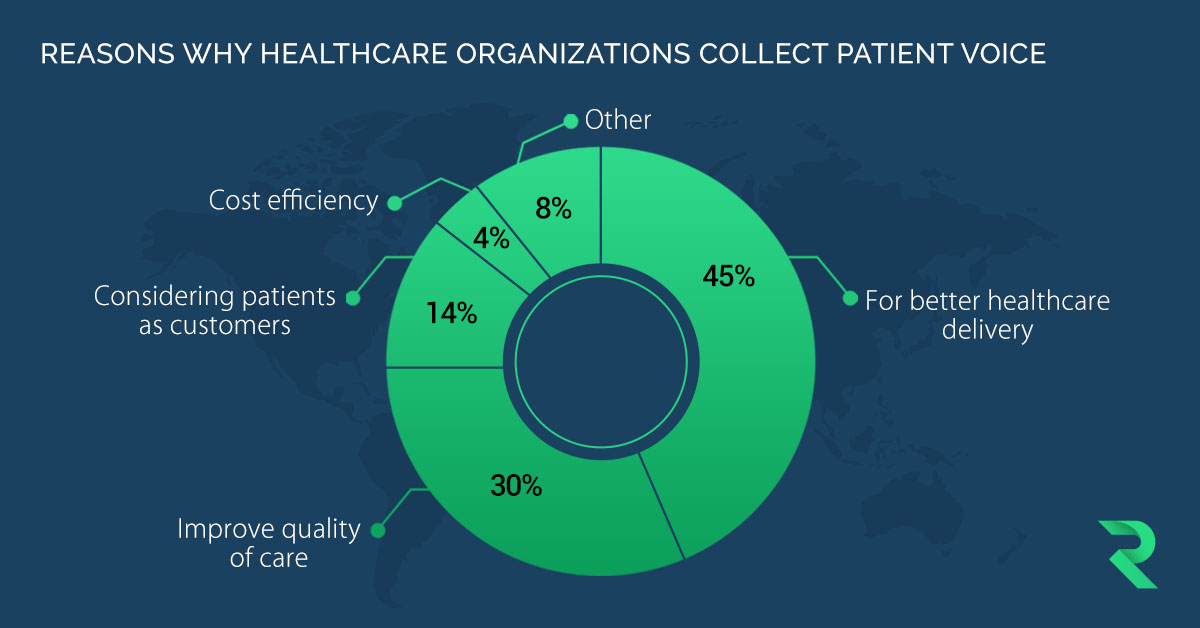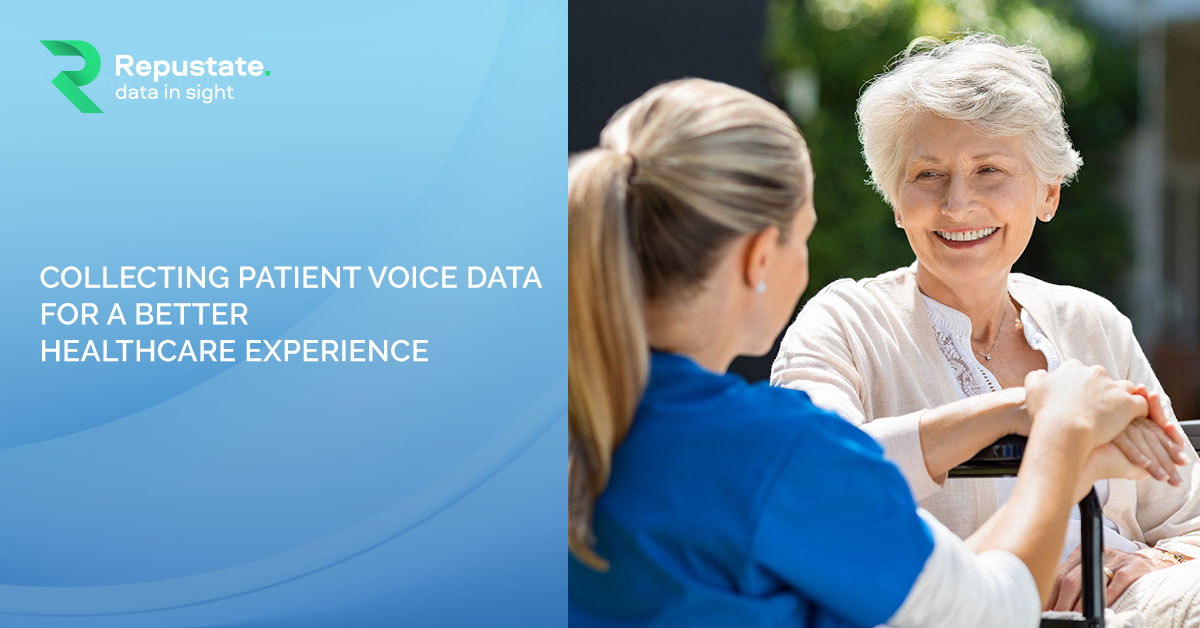How To Collect Patient Voice Data For A Better Healthcare Experience
Patient voice helps healthcare providers understand patient requirements and deliver improved quality of care. It is crucial information that hospitals use to ensure that doctors, patients, and caregivers all feel heard in an evolving healthcare system. There are two important aspects that healthcare providers need to address with regards to patient voice. The first is finding the right sources for patient voice, and the second is having an unbiased system of collecting the feedback. In this blog, our focus is on the former, wherein we explore reliable sources from where we can get patient voice in healthcare.
How patient voice helps the healthcare experience
Receiving timely feedback leads to situational awareness that policy-makers and healthcare delivery organizations can use to assess any shortcomings in care services. Patient voice-lead healthcare data analytics helps organizations develop a data-backed roadmap that can be used to prioritize healthcare programs and strategize operational efficiencies. It also helps hospitals (teaching, military, or general) to achieve benchmark performance scores to meet global healthcare accreditations through a focus on patient-centered care.
Whether underlined by legislative healthcare policies or driven by individual goals of an organization, patient voice can be instrumental in enhancing patient experience. Conducting sentiment analysis on patient voice data is an assured way to gain granular insights on all facets of healthcare that matter.
Reasons why healthcare organizations collect patient voice

What are the sources of gathering patient voice in healthcare?

Patient voice can be collected through EHRs, video and telehealth consults, surveys, patient forums, customer support calls, social media, and many similar means. Here are some details on such resources:
Electronic health records (EHR)
Integrated EHR systems are a great source of collecting quality-of-life metrics. They are being used more frequently to overcome the limited time available for clinical appointments. Administrators are using EMRs while patients wait, to obtain symptoms they are experiencing as well as recent medical history. This has lead to more accurate data, as well as an opportunity to incorporate patient voice in healthcare. Take a look at how Repustate’s semantic search solution helped a US-based healthcare organization manage their EHR data.
Telehealth & Video consultation records
Virtual care records are a very important source of patient voice since the technology to deliver virtual healthcare has been around for decades. The crisis created by the Covid19 pandemic has only re-iterated the fact that telemedicine/telehealth and video consultations are as essential as in-person interactions. In fact, Canada itself has the elite Virtual Care Task Force (VCTF) - an organization set up by the Canadian Medical Association and the Royal College of Physicians and Surgeons, to provide recommendations for scaling up virtual medical services.Repustate’s video content analysis solution allows healthcare providers to analyse data from these video consultations. It also allows them to search for relevant topics, themes, and entities, in order to extract the information they are looking for.
Customer support calls
Healthcare customer support call services bear the important task of customer relationship management while enabling increased patient engagement. They provide significant information for healthcare data analytics that hospitals and medical practices can use to judge gaps in their services. Customer support calls also handle insurance processing. This means that it’s not just patient experience in medical care that can be measured but also the operational end of billing and insurance.
Voice notes during consultations
Doctors often make voice notes during consults in order to have a real-time record of their diagnosis and what they are seeing. Many patients too want to record a clinical encounter so that they can record their doctor’s advice or share information with their family. Driven by an increase in voice notes, hospitals are encouraging apps that are data secure, patient-driven, and have clear legal terms. They are linked to the patient’s medical records and are accessible to both the patient and doctor. These recordings of patient voice in healthcare can be organized and pulled up for future medical references, or to know the reasons behind positive and negative feedback.
Active patient groups (APGs)
Active patients groups consist of patients who participate as partners with their healthcare providers in order to have a healthier life and a faster recovery. APGs are especially active in chronic disease management. They collect vital healthcare information from their doctor visits and share their experience on forums and within the community so that others too can benefit from the information. For example, the Patient Voices Network (PVN) is one such APG group based in British Columbia, Canada, comprising patients, families and caregivers who work together with healthcare partners to better the state’s healthcare system. It just goes to show how noteworthy data from active patient groups can be for patient-care analytics.
Post-appointment surveys
Surveys help in raising the bar for quality health care. They provide healthcare companies with benchmark performance scores against which they can compare their performance, to ensure and maintain global accreditation. Many healthcare providers partner with survey research companies to capture this vital information. Press Ganey, for example, is one of the research companies Repustate’s healthcare client in the Middle East, Health-Links, partners with for healthcare data. Press Ganey issues millions of surveys on an annual basis for a comparative data set. This includes data from more than 50% of acute care hospitals in the US. Health-Links analyses all this data using the Repustate sentiment analysis model to help policy makers and healthcare leaders make informed decisions.
In-care questionnaires
In-care patient experience can be a very productive source in collecting patient voice data. Right from measuring out-of-hour care to collecting vital information on symptoms after receiving medicine dosage, in-care questionnaires can shed light on some important statistics. Aspect-based sentiment analysis of the answers received from in-care queries can give hospitals an accurate view of how patients perceive specific areas within the healthcare delivery system.
Feedback web forms or emails
Many patients prefer feedback web forms and emails as it gives them an opportunity to let the hospitals and doctors know how their experience was. It allows them to gather their thoughts and write, rather than given an impromptu reply on a telephone call from customer support. This is extremely useful in cases of patients who have undergone stressful recovery and may need a long time to recuperate.
Social media channels and patient forums
Whether it’s for a critical surgery or a regular eye exam, it’s common practice to send a request to the patient for a review on public forums like Facebook pages, and medical review websites like RateMDs, Health Grade, etc. All this patient voice data from social media websites and review forums can be gathered and analyzed for sentiment analysis.
Discover More: NLP in Healthcare
What are the challenges in the patient voice process?
Biased reporting of feedback, technology issues in feedback collection, manual interpretations, time and resource costs in analyzing large data, and language barriers are often the main challenges in processing patient voice in healthcare. Let us elaborate them:
Biased reporting:
The main challenge is collecting and cohesively using patient voice is the biased reporting of feedback. Many times a data analyst will pay attention only to negative or positive experiences that are striking, and leave out ones that seem unremarkable.
Technology issues:
Patient perspectives often get filtered regardless of the medium used to collect them, such as web forms, support calls, comments, voice notes. Added to this, patients may not be used to certain technologies or perhaps lose patience such as during IVR calls
Inaccuracy: There is greater inaccuracy when there is manual analysis of the feedback involved, since human bias can play a role in interpretation of comments and patient notes.
Language barriers:
When the data is in different languages, either because the demography is diverse or the data is from different geographical locations, language translations can dilute the core message of the comment.
Resource costs:
Analysing hundreds of patient voice comments and notes can be a very time-consuming and expensive task when done manually. This task can seem almost impossible when the patient voice data keeps growing continually.
An AI-driven semantic solution for patient voice analysis
Most of the challenges in processing patient voice in healthcare can be overcome by an AI-driven semantic approach towards data. Healthcare organisations need a solution that is intelligent in design. One that allows semantic organizing and search of all data that is relevant to doctors, patients, caregivers, involved stakeholders, and policy decision makers. The model needs to be robust in speed and capacity so that terabytes of data are processed without downtime. More importantly, it should be capable of conducting sentiment analysis on the patient voice data accurately. This means that it should understand the data in its native language without the need to translate it into English or any other language for analysis.
Repustate’s sentiment analysis and semantic search solution provides significant objectivity and accuracy in processing patient voice. It addresses all the challenges in patient voice analytics. That’s why our sentiment analysis model is helping our healthcare clients across continents in processing their precious information.
 Home
Home
 Mar 27, 2021
Mar 27, 2021

 Jeremy Wemple
Jeremy Wemple
 Dr. Ayman Abdelazem
Dr. Ayman Abdelazem
 Dr. Salah Alnajem, PhD
Dr. Salah Alnajem, PhD
 David Allen
David Allen

 Repustate Team
Repustate Team

